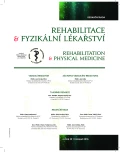Performance Induction Stimulation in the Terapy of Muculoskeletal Apparatus Conditions - A Pilot Study
Authors:
J. Pětioký 1; Z. Váňa 1; D. Šubert 1; D. Žarković 2; O. Prouza 2; V. Bittner 3
Authors‘ workplace:
Rehabilitační ústav Kladruby
1; Katedra anatomie a biomechaniky, Fakulta tělesné výchovy a sportu, Univerzita Karlova v Praze
2; Katedra matematiky a didaktiky matematiky, Fakulta přírodovědně-humanitní a pedagogická, Technická univerzita v Liberci
3
Published in:
Rehabil. fyz. Lék., 23, 2016, No. 4, pp. 195-200.
Category:
Original Papers
Overview
Background:
Repetitive peripheral inductive stimulation is a solution in musculoskeletal pain management in medical branches such as neurology, orthopaedics, rehabilitation and physical medicine. Therapy is based on the principle of time-varying electromagnetic field passing through neural and muscular tissue, in which electric currents are induced. By affecting conductive tissue, a chain reaction including changes in action potential and leading to muscle contraction is performed.
Aim:
Aim of the pilot study was to investigate immediate pain relief effect of the repetitive peripheral inductive stimulation device BTL-6000 Super Inductive System (BTL Industries Ltd.) in musculoskeletal diseases.
Methods:
31 subjects from Rehabilitation Center Kladruby were comprised in the pilot study. Subjects underwent approx. 7 therapies individually. A hand-held applicator type „focus field“ was used. Pulse repetition rates matching with gate theory and peripheral pattern theory were applied to achieve pain relief effect. A Visual Analog Scale (VAS) was used to evaluate pain before and after each therapy.
Results:
Immediate pain relief effect of the repetitive peripheral inductive stimulation in 62% patients with musculoskeletal diseases was observed.
Conclusion:
Despite small number of subjects, decrease of painful perception and pain relief effect were achieved. Although, the study design does not allow comparison with placebo effect, statistically significant (α = 0.2) immediate pain relief effect in 50 - 74 % of subjects might be expected.
Keywords:
pain, pain relief effect, gate control theory, peripheral pattern theory, repetitive peripheral inductive stimulation, vertebrogenic algic syndrome, Visual Analog Scale
Sources
1. BARKER, A. T., JALINOUS, R., FREESTON, I. L.: Non-invasive magnetic stimulation of human motor cortex. Lancet, roč. 1, 1985, č. 8437, s. 1106-1107. ISNN 0140-6736.
2. BEAULIEU, L. D., SCHNEIDER, C.: Effects of repetitive peripheral magnetic stimulation on normal or impaired motor control. A review. Clin. Neurophysiol., roč. 43, 2013, č. 4, s. 251-260. ISNN 0987-7053.
3. BIJUR, P. E., SILVER, W., GALLAGHER, E. J.: Reliability of the visual analog scale for measurement of acute pain. Acad. Emerg. Med., roč. 8, 2001, č. 12, s. 1153-1157. ISSN 1069-6563.
4. BONICA, J. J.: The need of a taxonomy. Pain, roč. 6, 1979, č. 3, s. 247-248. ISSN 0304-3959.
5. DOGAN, S. K., AY, S., EVCIK, D., KURTAIS, Y., GÖKMEN ÖZTUNA, D.: The utility of daces pain scale in a chronic musculoskeletal pain model. Pain Medicine, roč. 13, 2012, č. 1, s. 125-130. ISNN 1526-2375.
6. GEBHART, G. F., GOLD, M. S.: Nociceptor sensitization in pain pathogenesis. Nat. Med., roč. 16, 2010, č. 11, s. 1248-1257. ISNN 1078-8956.
7. GROZOIU, L., SAVULESCU, S., HESSE, S., BIGHEA, A., BERTEANU, M.: Repetitive peripheral magnetic stimulation in stroke rehabilitation: A case study. IJSSH, roč. 6, 2016, č. 8, s. 608-611. ISNN 2010-3646.
8. HAWKER, G. A., MIAN, S., KENDZERSKA, T., FRENCH, M.: Measures of adult pain. Arthrit Care Res., roč. 63, 2011, č. 11, s. 240-252. ISNN 2151-4658.
9. KLIGER, M., STAHL, S., HADDAD, M., SUZAN, E., ADLER, R., EISENBERG, E.: Measuring the intensity of chronic pain: Are the Visual Analogue Scale and the Verbal Rating Scale interchangeable? Pain Practice, roč. 15, 2015, č. 6, s. 538-547. ISNN 1530-7085.
10. KRAUSE, P., STRAUBE, A.: Peripheral repetitive magnetic stimulation induces intracortical inhibition in healthy subjects. Neurol. Res., roč. 30, č. 7, s. 690-694. ISSN 0161-6412.
11. LO,Y. L., FOOK-CHONG, S., HUERTO, A. P., GEORGE, J. M.: A randomized, placebo-controlled trial of repetitive spinal magnetic stimulation in lumbosacral spondylotic pain. Pain Medicine, roč. 12, 2011, č. 7, s. 1526-2375. ISNN 1526-2375.
12. MELZACK, R., WALL, P. D.: Pain mechanisms : A new theory. Pain Clinic, roč. 7, 1994, č. 1, s. 57-72. ISNN 0169-1112.
13. MELZACK, R.: Gate control theory–On the evolution of pain concepts. Pain Forum, roč. 5, 1996, č. 2, s. 128-150. ISSN 1058-9139.
14. PODĚBRADSKÝ, J., PODĚBRADSKÁ, R.: Fyzikální terapie: manuál a algoritmy. Praha, Grada Publishing, 2009, s. 34-38.
15. PUJOL, J., PASCUAL, L.: The effect of repetitive magnetic stimulation on localised pain in skeletal muscles. Neuro Report, 1998, č. 9, s. 1745-1748.
16. SCHOLZ, J., WOOLF, C. J.: Can we conquer pain? Nat.Neurosci, roč. 5, 2002, č. 11, s. 1062-1067. ISNN 1097-6256.
17. SMANIA, N., CORATO, E., FIASCHI, A., PIETROPOLI, P., AGLIOTI, S. M., TINAZZI, M.: Therapeutic effects of peripheral repetitive magnetic stimulation on myofascial pain syndrome. J. Neurol., roč. 114, 2003, č. 2, s. 350-358. ISNN 1388-2457.
18. SMANIA, N., CORATO, E., FIASCHI, A., PIETROPOLI, P., AGLIOTI, S. M., TINAZZI, M.: Repetitive magnetic stimulation: A novel therapeutic approach for myofascial pain syndrome. J. Neurol., roč. 252, 2005, č. 3, s. 307-314. ISNN 0340-5354.
19. TERAO, Y., UGAWA, Y.: Basic mechanisms of TMS. J. Clin. Neurophysiol., roč. 19, 2002, č. 4, s. 322-343
20. URBAN, J.: Ústní sdělení (Intenzivní kurz fyzikální terapie A – 8. ledna 2016.)
Labels
Physiotherapist, university degree Rehabilitation Sports medicineArticle was published in
Rehabilitation & Physical Medicine

2016 Issue 4
Most read in this issue
- Congenital Synostosis of Vertebras C4 a C5
- The Relation between Stress, Psychoneurotic Symptoms and Traits, and Neck Pain
- Functional Independence Measure as an Indicator of Patient Disability - Evaluation of Practical Experiences
- CI therapy – a Chance for Chronic Patients after Brain Damage
